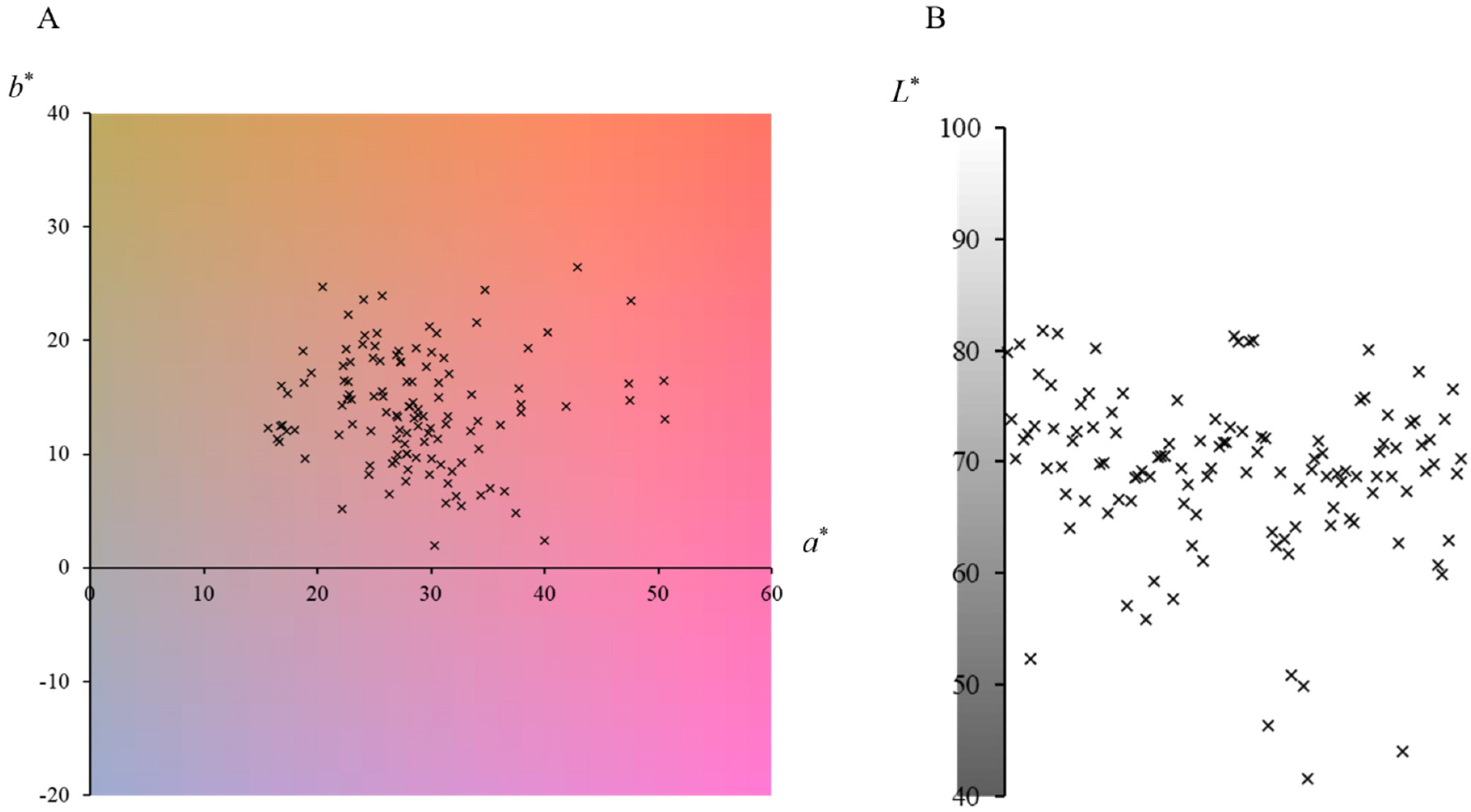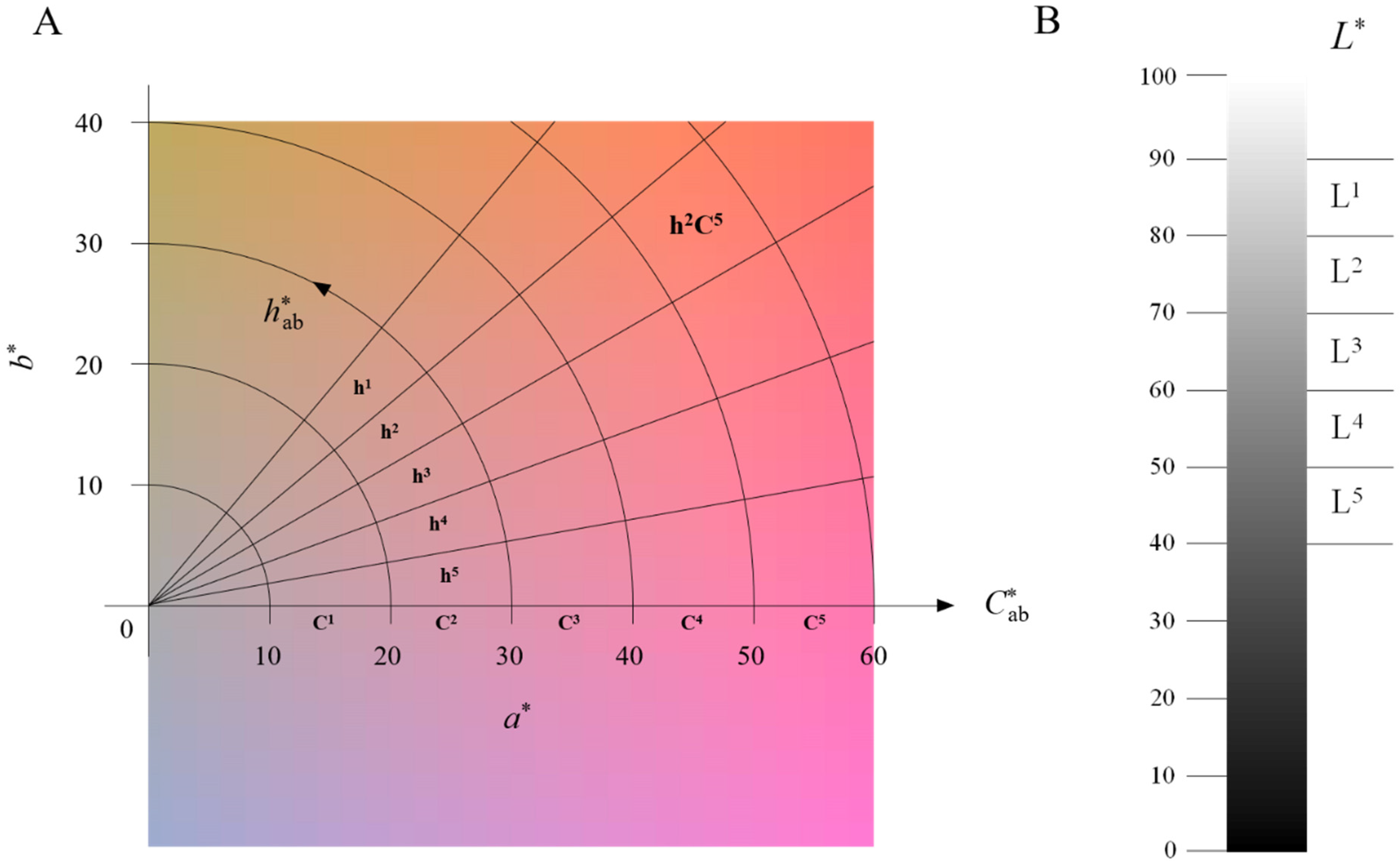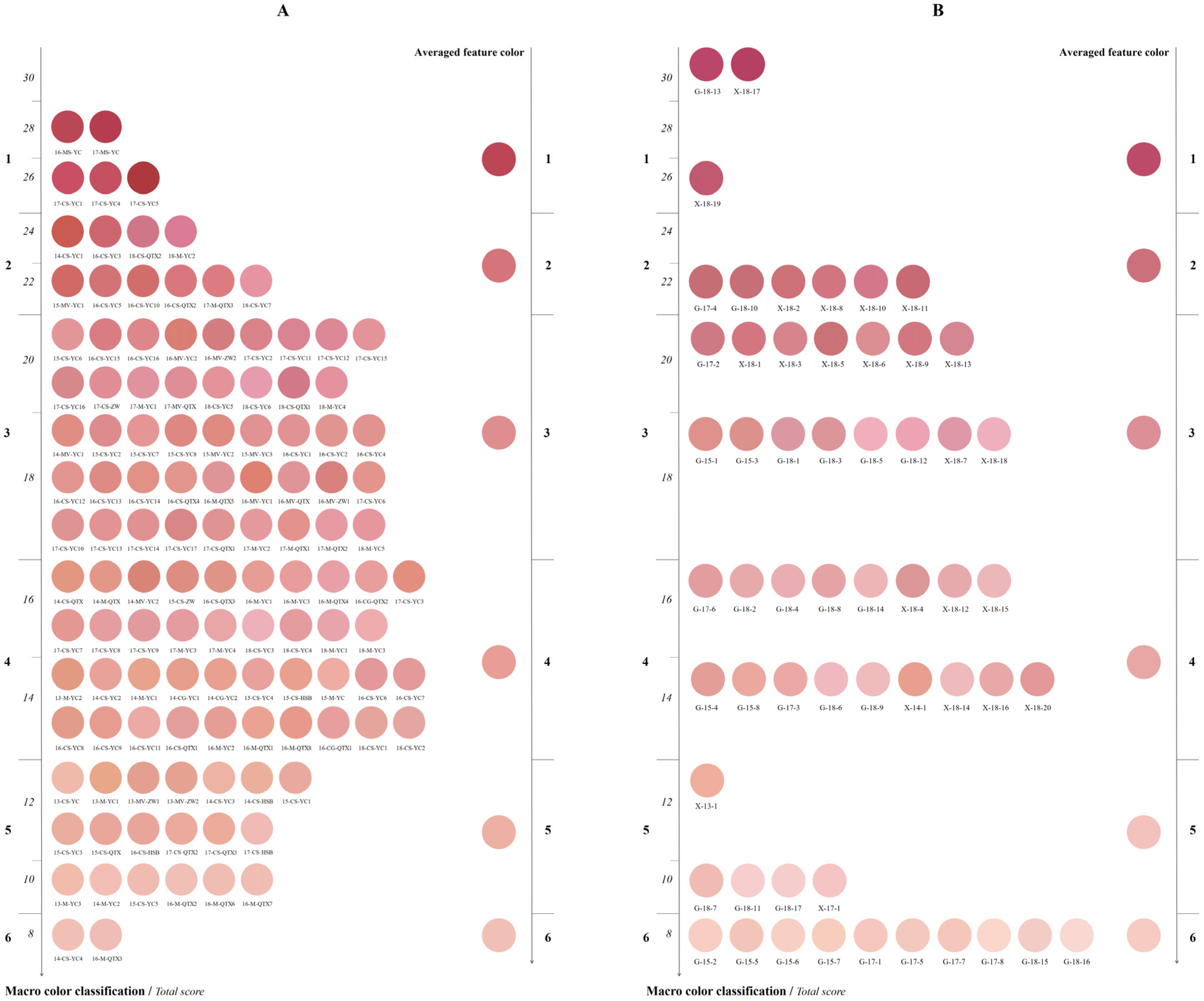A New Approach for Quantitative Classification of Red Wine Color from the Perspective of Micro and Macro Levels
Abstract
1. Introduction
2. Materials and Methods
2.1. Wine Samples
2.2. Measurement of CIELAB Color Parameters
2.3. Visual Representation
2.4. Statistical Analysis
3. Results and Discussion
3.1. Visual Representation of the Color of Wine Samples
3.2. Micro-Classification of the Color of Wine Samples Based on the CIELAB Parameters
3.2.1. Micro-Level Sub-Classification of Chromaticity
3.2.2. Micro-Level Sub-Classification of Lightness
3.2.3. Micro-Classification of Wine Color
3.3. Macro-Classification of the Color of Wine Samples Based on the Micro-Classification
3.3.1. Macro-Classification Method
3.3.2. Macro-Classification of Red Wine Color
- (1)
- Red wines of the same vintage: As shown in Table 3, although from the same vintage, red wines are in different classifications, suggesting that red wines in lower classifications may have better initial color properties, suitable aging and storage conditions, and relatively more stable potential of color aging.
- (2)
- Red wines of the same classification: As shown in Figure 4, there are many red wines with different vintages in the same classification. Aged red wines present relatively equal color properties with younger red wines, which means these younger red wines exhibited relatively faster rates of color decay and aging. Furthermore, we can trace and analyze the causes of this situation, such as the variety, origin, and fermentation techniques used that influence the initial phenolic composition and/or inappropriate aging and storage conditions and management.
- (3)
- Several specific red wines: When monitoring changes in the macro-level color classifications of several red wines during same aging and storage conditions, we can compare and evaluate their color aging degree and color aging potential. Furthermore, we can trace and analyze the causes of their macro-level color classification changes, such as the variety, origin, and fermentation techniques used that influence the initial phenolic composition.
- (4)
- Color aging rate and color prediction: Based on long-term annual change data for a large number of macro-level color classifications of red wines, we expect to obtain average macro-level color classification change rates for different single-variety red wines, such as the index . At that time, we can use the absolute terms , , and as standards and indices to easily assess the degree, potential, and rate of color aging for specific red wines and further analyze the relationship between them and the complex factors that affect the color of red wine, which includes variety, origin, vintage, various fermentation techniques, and even storage and aging conditions. We can even predict the color evolution of red wines, according to the ΔX, , and the average color evolution. Admittedly, the realization of this application also requires a large number of red wine samples and dynamic color data.
3.4. Applicability Verification
4. Conclusions
- (1)
- To a certain extent, the overall color characteristics of 119 dry red wines can be roughly summarized as follows: mainly ruby red, garnet, and brick red with medium saturation or lower and slightly bright. Even if there is a tendency for a concentrated distribution of wine colors, the color of each wine sample still shows uniqueness, and there is a high enough degree of discrimination between wine samples to be used as the basis for wine color classification.
- (2)
- The lightness L* (lightness), hue , and chroma (chromaticity) are divided into five sub-classifications each, and 125 micro-level color classifications such as h3C5L4, h2C2L1, and h1C3L2 are obtained by combining the three, which is convenient for describing, comparing, distinguishing, and associating the color characteristics of red wine.
- (3)
- On the basis of the micro-level wine color classification, a red wine color scoring and classification standard based on the color evolution of red wines over time is introduced. The micro-level color classifications are divided into six macro-level color classifications, which provides possible solutions for red wine color control, comparison, and evaluation.
- (4)
- In order to further verify and illustrate the applicability and flexibility of this system, 56 extra representative red wine samples were quantitatively classified. As expected, although the scheme is based on 119 wine samples, it has a consistently outstanding classification effect on wine samples beyond these 119 wine samples. It can be seen that the scheme has a high degree of practicability and flexibility.
Supplementary Materials
Author Contributions
Funding
Institutional Review Board Statement
Informed Consent Statement
Data Availability Statement
Acknowledgments
Conflicts of Interest
References
- Ku, K.H.; Kim, H.J.; Jeong, M.C. Relationship between quality characteristics and skin color of ‘Fuji’ Apples (Malus domestica Borkh.). J. Food Meas. Charact. 2019, 13, 1935–1946. [Google Scholar] [CrossRef]
- Pathare, P.B.; Opara, U.L.; Al-Said, A.J. Colour measurement and analysis in fresh and processed foods: A review. Food Bioprocess. Technol. 2013, 6, 36–60. [Google Scholar] [CrossRef]
- Caridi, A.; Romeo, R.; De, B.A.; Masaneo, C.; Poiana, M. Long-term effects of different starter yeasts on colour and natural antioxidant power of red wines. Eur. Food Res. Technol. 2021, 247, 2391–2398. [Google Scholar] [CrossRef]
- Jackson, R.S. Wine Tasting: A Professional Handbook, 2nd ed.; Academic Press: Salt Lake City, UT, USA, 2009. [Google Scholar]
- Parpinello, G.P.; Versari, A.; Chinnici, F.; Galassi, S. A Relationship among sensory descriptors, consumer preference and color parameters of Italian Novello red wines. Food Res. Int. 2009, 42, 1389–1395. [Google Scholar] [CrossRef]
- Morrot, G.; Brochet, F.; Dubourdieu, D. The color of odors. Brain Lang. 2001, 79, 309–320. [Google Scholar] [CrossRef] [PubMed]
- Parr, W.V.; White, G.; Heatherbell, D.A. The nose knows: Influence of color on perception of wine aroma. J. Wine Res. 2003, 14, 79–101. [Google Scholar] [CrossRef]
- Spence, C. On the psychological impact of food colour. Flavour 2015, 4, 21. [Google Scholar] [CrossRef]
- Fairchild, M.D. Visual and photographic assessment of wine color. Color Res. Appl. 2022, 48, 21–31. [Google Scholar] [CrossRef]
- Fairchild, M.D. The colors of wine. Int. J. Wine Res. 2018, 10, 13–31. [Google Scholar] [CrossRef]
- Hernández, B.; Sáenz, C.; Hoz, J.; Alberdi, C.; Alfonso, S.; Dieiro, J.M. Assessing the color of red wine like a taster’s eye. Color Res. Appl. 2009, 34, 153–162. [Google Scholar] [CrossRef]
- Martin, M.L.G.M.; Ji, W.; Luo, R.; Hutchings, J.; Heredia, F.J. Measuring colour appearance of red wines. Food Qual. Prefer. 2007, 18, 862–871. [Google Scholar] [CrossRef]
- Martínez, J.A.; Melgosa, M.; Pérez, M.M.; Hita, E.; Negueruela, A.I. Note. Visual and instrumental color evaluation in red wines. Food Sci. Technol. Int. 2001, 7, 439–444. [Google Scholar] [CrossRef]
- Yu, X.; Liu, K.; Wu, D.; He, Y. Raisin quality classification using least squares support vector machine (lssvm) based on combined color and texture features. Food Bioprocess. Technol. 2012, 5, 1552–1563. [Google Scholar] [CrossRef]
- Patil, N.K.; Malemath, V.S.; Yadahalli, R.M. Color and texture based identification and classification of food grains using different color models and haralick features. Int. J. Comput. Sci. Eng. 2011, 3, 3669. [Google Scholar]
- Pedreschi, F.; Mery, D.; Bunger, A.; YaEz, V. Computer vision classification of potato chips by color. J. Food Process Eng. 2011, 34, 1714–1728. [Google Scholar] [CrossRef]
- Vélez-Rivera, N.; Blasco, J.; Chanona-Pérez, J.; Calderón-Domínguez, G.; de Jesús Perea-Flores, M.; Arzate-Vázquez, I. Computer vision system applied to classification of “manila” mangoes during ripening process. Food Bioprocess. Technol. 2014, 7, 1183–1194. [Google Scholar] [CrossRef]
- Mery, D.; Pedreschi, F.; Soto, A. Automated Design of a Computer Vision System for Visual Food Quality Evaluation. Food Bioprocess. Technol. 2013, 6, 2093–2108. [Google Scholar] [CrossRef]
- León, K.; Mery, D.; Pedreschi, F.; Leon, J. Color measurements in L*a*b* units from RGB digital images. Food Res. Int. 2006, 106, 1084–1091. [Google Scholar] [CrossRef]
- OIV. Compte Rendu des Travaux, 34 Session de la OIV, March 1994, Paris. Off. J. Eur. Commun. 1994, 34, 3-X-90:167. [Google Scholar]
- Pavlidis, G. Colour sorting of translucent samples. J. Adv. Comput. Sci. Technol. 2015, 4, 265–272. [Google Scholar] [CrossRef]
- Snipes, M.; Taylor, D.C. Model selection and Akaike Information Criteria: An example from wine ratings and prices. Wine Econ. Policy 2014, 3, 3–9. [Google Scholar] [CrossRef]
- Agrawal, G.; Kang, D.K. Wine Quality Classification with Multilayer Perceptron. Int. J. Internet Broadcast. Commun. 2018, 10, 25–30. Available online: https://www.earticle.net/Article/A332199 (accessed on 4 February 2023).
- Petropoulos, S.; Karavas, C.S.; Balafoutis, A.T.; Paraskevopoulos, I.; Kallithraka, S.; Kotseridis, Y. Fuzzy logic tool for wine quality classification. Comput. Electron. Agric. 2017, 142, 552–562. [Google Scholar] [CrossRef]
- Boisier, B.; Mansouri, A.; Gouton, P. Wine color characterization and classification for nuances reproduction. Fifth Int. Conf. Signal Image Technol. Internet Based Syst. 2009, 25, 93–98. [Google Scholar] [CrossRef]
- Li, S.Y.; Zhu, B.Q.; Li, L.J.; Duan, C.Q. Extensive and objective wine color classification with chromatic database and mathematical models. Int. J. Food Prop. 2017, 2 (Suppl. 3), S2647–S2659. [Google Scholar] [CrossRef]
- Fan, S.Y.; Liu, C.Y.; Li, Y.K.; Zhang, Y. Visual Representation of Red Wine Color: Methodology, Comparison and Applications. Foods 2023, 12, 924. [Google Scholar] [CrossRef]
- Pérez-Caballero, V.; Ayala, F.; Federico Echávarri, J.; Negueruela, A.I. Proposal for a New Standard OIV Method for Determination of Chromatic Characteristics of Wine. Am. J. Enol. Vitic. 2003, 54, 59–62. [Google Scholar] [CrossRef]
- Gupta, A.K.; Medhi, M.; Chakraborty, S.; Yumnam, M.; Mishra, P. Development of rapid and non-destructive technique for the determination of maturity indices of pomelo fruit (Citrus grandis). J. Food Meas. Charact. 2021, 15, 1463–1474. [Google Scholar] [CrossRef]
- Garcia, M.B.; Ambat, S.; Adao, R.T. Tomayto, Tomahto: A Machine Learning Approach for Tomato Ripening Stage Identification Using Pixel-Based Color Image Classification. In Proceedings of the 2019 IEEE 11th International Conference on Humanoid, Nanotechnology, Information Technology, Communication and Control, Environment, and Management (HNICEM), Laoag, Philippines, 29 November–1 December 2020. [Google Scholar] [CrossRef]
- Ellis, L.P.; Kok, C. Colour Changes in Blanc de Noir Wines during Ageing at Different Temperatures and its Colour Preference Limits. South Afr. J. Enol. Vitic. 2017, 8, 16–22. [Google Scholar] [CrossRef]
- Kanavouras, A.; Coutelieris, F.; Karanika, E.; Kotseridis, Y.; Kallithraka, S. Colour change of bottled white wines as a quality indicator. Oeno One 2020, 54, 543–551. [Google Scholar] [CrossRef]
- Lvarez, J.E.; Barral, M.; Corral, M.F.; Lage, M.; Simal-Gandara, J. Bottle aging and storage of wines: A review. Molecules 2021, 26, 713. [Google Scholar] [CrossRef]
- Cliff, M.A.; King, M.C.; Schlosser, J. Anthocyanin, phenolic composition, colour measurement and sensory analysis of BC commercial red wines. Food Res. Int. 2007, 40, 92–100. [Google Scholar] [CrossRef]
- Zhang, X.K.; Lan, Y.B.; Huang, Y.; Zhao, X.; Duan, C.Q. Targeted metabolomics of anthocyanin derivatives during prolonged wine aging: Evolution, color contribution and aging prediction. Food Chem. 2020, 339, 127795. [Google Scholar] [CrossRef] [PubMed]
- Laitila, J.E.; Salminen, J.P. Relevance of the Concentrations and Sizes of Oligomeric Red Wine Pigments to the Color Intensity of Commercial Red Wines. J. Sci. Food Agr. 2020, 68, 3576–3584. [Google Scholar] [CrossRef]
- Avizcuri, J.M.; Sáenz-Navajas, M.P.; Echávarri, J.F.; Ferreira, V.; Fernández-Zurbano, P. Evaluation of the Impact of Initial Red Wine Composition on Changes in Color and Anthocyanin Content during Bottle Storage. Food Chem. 2016, 213, 123–134. [Google Scholar] [CrossRef]
- Estebana, M.D.; Ubeda, C.; Heredia, F.J.; Catania, A.A.; Assof, M.V.; Fanzone, M.L.; Jofre, V.P. Impact of closure type and storage temperature on chemical and sensory composition of malbec wines (mendoza, argentina) during aging in bottle. Food Res. Int. 2019, 125, 108553. [Google Scholar] [CrossRef] [PubMed]
- Waterhouse, A.L.; Miao, Y. Can Chemical Analysis Predict Wine Aging Capacity? Foods 2021, 10, 654. [Google Scholar] [CrossRef]
- Menn, N.L.; Marchal, R.; Sills, H.C.; Tempere, S.; Casenave, P.; Marchand, S.; de Revel, G.; Marchand, S. Development of a new sensory analysis methodology for predicting wine aging potential. application to champagne reserve wines. Food Qual. Prefer. 2021, 94, 104316. [Google Scholar] [CrossRef]
- Li, Y.K.; Prejanò, M.; Toscano, M.; Russo, N. Oenin and quercetin copigmentation: Highlights from density functional theory. Front. Chem. 2018, 6, 245. [Google Scholar] [CrossRef]
- Li, Y.K.; Prejanò, M.; Toscano, M.; Russo, N. Oenin/syringic acid copigmentation: Insights from a theoretical study. Front. Chem. 2019, 7, 579. [Google Scholar] [CrossRef]
- Wang, X.J.; Li, Y.K.; Song, H.C.; Tao, Y.S.; Russo, N. Phenolic matrix effect on aroma formation of terpenes during simulated wine fermentation–Part I: Phenolic acids. Food Chem. 2021, 341, 128288. [Google Scholar] [CrossRef] [PubMed]
- Terradesa, S.; Wagnera, S.; Ros-Lisb, J.V.; Ibáñezd, J.; Andrés, A. Optical system for automatic color monitoring in heterogeneous media during vinification processes. Sens. Actuat. B-Chem. 2019, 285, 513–518. [Google Scholar] [CrossRef]




| Color Parameters | Value Range | Sub-Classification | Visual Perception | Score |
|---|---|---|---|---|
| ° | 0~10 | h5 | Purplish red | 10 |
| 10~20 | h4 | Ruby red | 8 | |
| 20~30 | h3 | Garnet | 6 | |
| 30~40 | h2 | Brick red | 4 | |
| 40~50 | h1 | Tawny | 2 | |
| 50~60 | C5 | Vivid | 10 | |
| 40~50 | C4 | Less vivid | 8 | |
| 30~40 | C3 | Pale | 6 | |
| 20~30 | C2 | Dull | 4 | |
| 10~20 | C1 | Gloomy | 2 | |
| L* | 40~50 | L5 | Dark | 10 |
| 50~60 | L4 | Slightly dark | 8 | |
| 60~70 | L3 | Slightly bright | 6 | |
| 70~80 | L2 | Bright | 4 | |
| 80~90 | L1 | Intensely bright | 2 |
| Total Score | Macro-Level Color Classification |
|---|---|
| 6~8 | 6 |
| 10~12 | 5 |
| 14~16 | 4 |
| 18~20 | 3 |
| 22~24 | 2 |
| 26~30 | 1 |
| Vintage | Age | N | Min | Max | Mean | SD | Variance | Skewness | Kurtosis |
|---|---|---|---|---|---|---|---|---|---|
| 2013 | 6 | 6 | 4 | 5 | 4.83 | 0.408 | 0.167 | −2.449 | 6.000 |
| 2014 | 5 | 13 | 2 | 6 | 4.15 | 0.987 | 0.974 | −0.353 | 1.367 |
| 2015 | 4 | 15 | 2 | 5 | 3.73 | 0.961 | 0.924 | 0.059 | −1.055 |
| 2016 | 3 | 40 | 1 | 6 | 3.50 | 0.987 | 0.974 | 0.000 | 0.551 |
| 2017 | 2 | 31 | 1 | 5 | 3.10 | 1.076 | 1.157 | −0.375 | 0.390 |
| 2018 | 1 | 14 | 2 | 4 | 3.21 | 0.802 | 0.643 | −0.437 | −1.229 |
Disclaimer/Publisher’s Note: The statements, opinions and data contained in all publications are solely those of the individual author(s) and contributor(s) and not of MDPI and/or the editor(s). MDPI and/or the editor(s) disclaim responsibility for any injury to people or property resulting from any ideas, methods, instructions or products referred to in the content. |
© 2023 by the authors. Licensee MDPI, Basel, Switzerland. This article is an open access article distributed under the terms and conditions of the Creative Commons Attribution (CC BY) license (https://creativecommons.org/licenses/by/4.0/).
Share and Cite
Fan, S.; Zhang, Y.; Li, Y. A New Approach for Quantitative Classification of Red Wine Color from the Perspective of Micro and Macro Levels. Fermentation 2023, 9, 519. https://doi.org/10.3390/fermentation9060519
Fan S, Zhang Y, Li Y. A New Approach for Quantitative Classification of Red Wine Color from the Perspective of Micro and Macro Levels. Fermentation. 2023; 9(6):519. https://doi.org/10.3390/fermentation9060519
Chicago/Turabian StyleFan, Shuyue, Yu Zhang, and Yunkui Li. 2023. "A New Approach for Quantitative Classification of Red Wine Color from the Perspective of Micro and Macro Levels" Fermentation 9, no. 6: 519. https://doi.org/10.3390/fermentation9060519
APA StyleFan, S., Zhang, Y., & Li, Y. (2023). A New Approach for Quantitative Classification of Red Wine Color from the Perspective of Micro and Macro Levels. Fermentation, 9(6), 519. https://doi.org/10.3390/fermentation9060519






